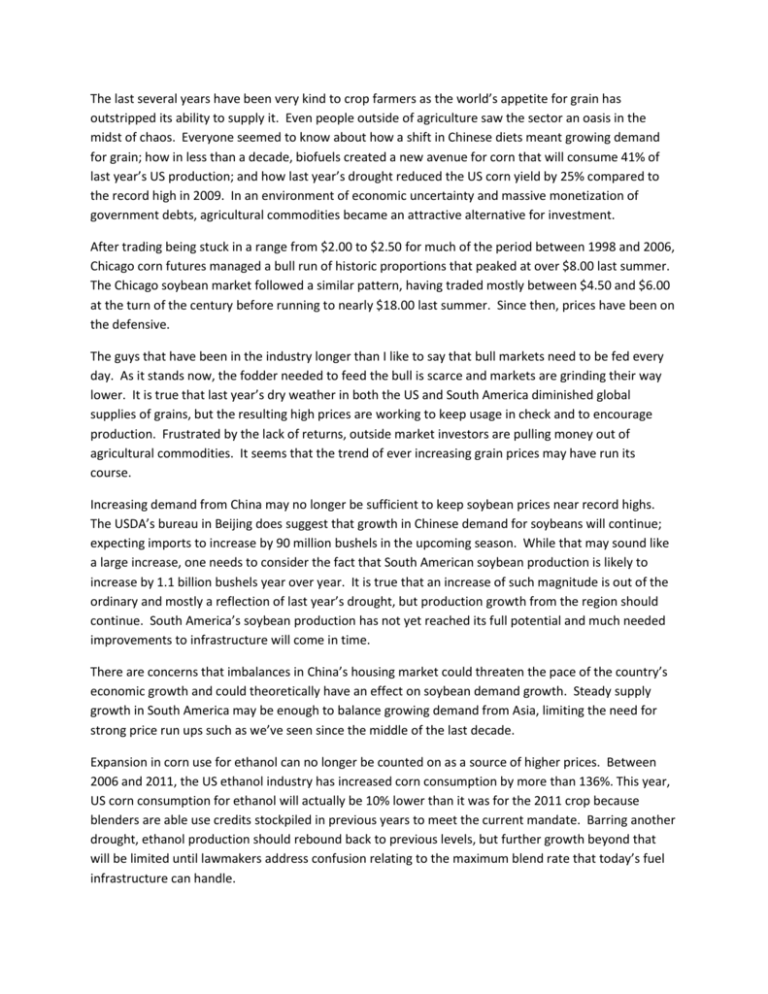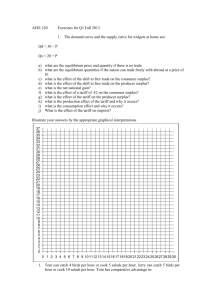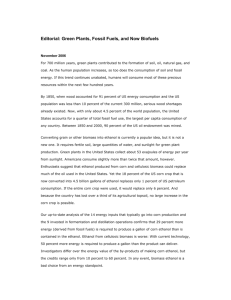The last several years have been very kind to crop farmers as the
advertisement

The last several years have been very kind to crop farmers as the world’s appetite for grain has outstripped its ability to supply it. Even people outside of agriculture saw the sector an oasis in the midst of chaos. Everyone seemed to know about how a shift in Chinese diets meant growing demand for grain; how in less than a decade, biofuels created a new avenue for corn that will consume 41% of last year’s US production; and how last year’s drought reduced the US corn yield by 25% compared to the record high in 2009. In an environment of economic uncertainty and massive monetization of government debts, agricultural commodities became an attractive alternative for investment. After trading being stuck in a range from $2.00 to $2.50 for much of the period between 1998 and 2006, Chicago corn futures managed a bull run of historic proportions that peaked at over $8.00 last summer. The Chicago soybean market followed a similar pattern, having traded mostly between $4.50 and $6.00 at the turn of the century before running to nearly $18.00 last summer. Since then, prices have been on the defensive. The guys that have been in the industry longer than I like to say that bull markets need to be fed every day. As it stands now, the fodder needed to feed the bull is scarce and markets are grinding their way lower. It is true that last year’s dry weather in both the US and South America diminished global supplies of grains, but the resulting high prices are working to keep usage in check and to encourage production. Frustrated by the lack of returns, outside market investors are pulling money out of agricultural commodities. It seems that the trend of ever increasing grain prices may have run its course. Increasing demand from China may no longer be sufficient to keep soybean prices near record highs. The USDA’s bureau in Beijing does suggest that growth in Chinese demand for soybeans will continue; expecting imports to increase by 90 million bushels in the upcoming season. While that may sound like a large increase, one needs to consider the fact that South American soybean production is likely to increase by 1.1 billion bushels year over year. It is true that an increase of such magnitude is out of the ordinary and mostly a reflection of last year’s drought, but production growth from the region should continue. South America’s soybean production has not yet reached its full potential and much needed improvements to infrastructure will come in time. There are concerns that imbalances in China’s housing market could threaten the pace of the country’s economic growth and could theoretically have an effect on soybean demand growth. Steady supply growth in South America may be enough to balance growing demand from Asia, limiting the need for strong price run ups such as we’ve seen since the middle of the last decade. Expansion in corn use for ethanol can no longer be counted on as a source of higher prices. Between 2006 and 2011, the US ethanol industry has increased corn consumption by more than 136%. This year, US corn consumption for ethanol will actually be 10% lower than it was for the 2011 crop because blenders are able use credits stockpiled in previous years to meet the current mandate. Barring another drought, ethanol production should rebound back to previous levels, but further growth beyond that will be limited until lawmakers address confusion relating to the maximum blend rate that today’s fuel infrastructure can handle. We have heard the story of slowing global grain demand and increasing production before; about a year ago to be specific. At that time, new crop grain prices were pretty much where they are today and thought to be headed lower without a weather problem. As it turned out however, a major weather problem did happen that sent prices for both corn and soybeans to record highs by summer. Could another drought give producers an opportunity to sell at last year’s prices again? It sure could, but things can also unfold quite differently. The chances of seeing another sub-125 bushel US corn crop are likely no better than seeing a 170-plus bushel crop. As a producer, be careful to not base your marketing plans on last year’s weather. Not forward selling enough crop this year may turn out to be just as regrettable as selling too early last year. Corn Chicago corn futures reflect the reality of the marketplace; too little corn now, and potentially too much by fall. As such, old crop corn values have been reluctant to trade below $7.00 per bushel while new crop corn futures have struggled to trade above $5.60 per bushel. Strong values for old crop corn have reduced the US’ competitiveness in export markets and have caused users to slow production or to look for alternative feedstocks. Wheat is displacing corn not only in feed markets, but to a degree in ethanol also as there are a few ethanol plants that are buying small amounts of wheat to blend into their corn. The USDA’s crucial Prospective Plantings report on March 28th will be highly scrutinized and will set the tone for new crop corn futures. Current estimates indicate that a monster crop of anywhere from 96 to 99 million bushels may be planted. If this were to happen and if weather were to co-operate, the US would experience a swing from deficit to surplus corn supplies of historic proportions. With last year’s drought still fresh in the minds of traders, new crop prices are likely to bleed weather premium slowly over time rather than fall dramatically. Ontario’s corn basis levels are the cheapest in North America as there is simply too much corn still sitting in bins that will eventually need to move. Our counterparts in some parts of the US where local supplies are depleted are enjoying historically strong basis levels, but our ability to hit them with our corn by truck or rail is limited. Corn basis is weakening but will need to weaken further in order to export any vessel quantities into these markets. Producer selling has picked up recently as producers question the wisdom of hanging on to $7.00 corn. Soybeans For several weeks, the nearby Chicago soybean market has been stuck in a range between $14.30 and $15.00 per bushel. News on the soybean front at this time is slow. As expected, the South American crop is big but slow to come to market due to logistical constraints. This is keeping a bid under old crop Chicago soybean futures because the US really cannot afford to continue its current export pace. At the same time, new crop soybean futures are continuing a slow grind lower. The market will get a solid look at acreage estimates when the USDA releases its all-important Prospective Plantings report at the end of March. The new crop ratio of corn versus soybean prices would indicate that soybeans may pick up a few more acres than originally thought. Spring exports of soybeans out of Ontario are neither likely nor necessary at this time. Much of the province’s large soybean crop was exported by vessel last fall, leaving little more than domestic crush behind. The domestic crushers were able to pick up some good coverage at the end of February and into the beginning of March, but producer selling has since slowed as many that were looking to sell at close to $15.00 per bushel have now done so. Soybean basis levels could firm if producer selling grinds to a halt, but holding onto old crop beans in the hopes of seeing a basis rally means challenging an inverse and betting that the Canadian dollar won’t quickly rebound. Soybean basis levels in Ontario have also benefitted greatly from a Loonie that is below $0.98. Were the dollar to run back to $1.01, local basis levels would be about $0.50 per bushel weaker Wheat The wheat market is well supported by corn values, as wheat is working its way into feed rations. The US has the cheapest wheat in the world to offer, which has finally led to a long awaited pick up in export sales. The increase in the rate of wheat disappearance into the feed and export markets in not likely enough to justify much higher prices at this time. Unless corn prices cheapen dramatically, Chicago wheat prices are likely to continue closely tracking corn values.





